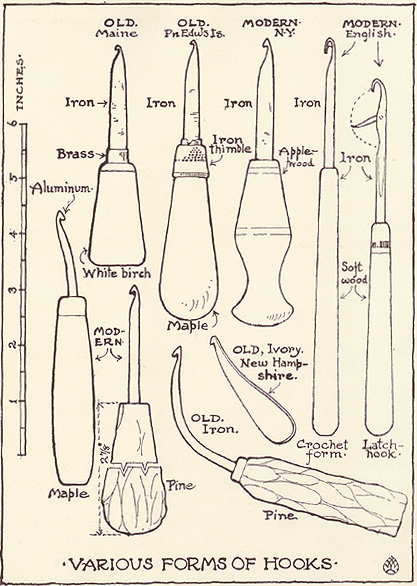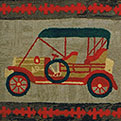How to make Hooked Rugs
Hooks
How to Hook
Cleaning
Storage and Shipping
Checking for Damage
Wall Hanging
Hooks

How to Hook

Cleaning Antique Rugs:
Hooked rugs, especially after years of use, require special and careful attention. The nature of the hooking technique and frequent presence of old fabrics and home-dyed colors dictate special handling when cleaning these rugs.
First the don't's:
Note: Don't attempt these cleaning techniques without reading the instructions following. *Do not attempt to clean your rug if you are not sure how to do it.
- Don't put a hooked rug into a washing machine, even on the so-called gentle cycle.
- Don't shake or beat a hooked rug, since shaking, beating, or even vacuuming from the back can dislodge the fabric from the foundation.
- Don't submerge a rug into water; surface cleaning is usually all that is required. (if not, see Deeper Cleaning)
Surface Cleaning:
For rugs that are only slightly dirty it is possible to vacuum only the front side, and only after you have covered the rug with screen and set your vacuum on low-suction. The safer technique is to sweep the rug gently with a soft brush. As mentioned above, do not vacuum the back but use a brush instead.
After sweeping or vacuuming, surface cleaning with a wet sponge or soft brush with cold water and a mild soap may be necessary. Using mostly suds and very little water (taking care not to soak the base), clean with a circular motion one six-inch-square area at a time, overlapping each area successively.
A light secong sponging with plain water will remove most of the remaining soap. After the rug is completely dry, loosened dirt and lint can be gently vacuumed out of the rug. (Please follow the vacuum instructions above).
Important:
Note: If you your rug is still dirty after these steps, do not go further until you check for color fastness on a very small area of the rug. (Printed calicoes and woven plaids are less likely to run than solid color fabrics, which are frequently home dyed).
Deeper Cleaning:
Remember that your rug should not be submerged into water unless completely necessary. The handling of the rug during this process must be done carefully and gently. You can soak your rug in cold water and gently clean with a soft brush or sponge wit mild soap. Be sure to rinse your rug several times but take special care while the rug is completely wet. Do Not wring or squeeze the water out of the rug. Instead, roll the rug in towels with the front side of the rug out. Do not hang the wet rug on a clothesline or on a rod because there is a chance of putting a permanent crease in it. The weight of the rug, if held by clothespins on a line, can break the foundation of the rug. Let the rug dry on a towel for a day on its front side, and a second day on its back.
Storing and Shipping Antique Rugs:
ROLL, DO NOT FOLD, ALWAYS HAVE THE RIGHT SIDE OUT
Folding a hooked rug with brea the base, especially if anything heavy is set on top. Rolling with the base out puts an unnecessary strain on the burlap and weakens the foundation. If a rug is to be stored for a long period, use a sheet or cloth to roll with it but do not use an airtight plastic bag. Fabric needs to breathe and they will sometimes rot or mildew in a plastic bag. Don't put a hooked rug in a hot, dry closet-like space or attic. The base of a rug can dry out and become brittle, destroying the strength and durability of the rug.
Note: Condition counts when buying a hooked rug. Professional storage and restoration is available but it's usually expensive. You must check a rug before purchasing for structurally unsound flaws that cannot be repaired.
Checking a rug for Flaws or Damage:
Here are some things to remember:
Check first for whether or not a rug is dry and brittle. You can usually ascertain this by lightly squeezing a portion of the rug in your hand. It should feel supple and pliable. A rug with weakened or rotten base is easily damaged or even destroyed just by normal use, and rugs in this condition are very difficult to repair. Hold a rug up to the light to look for small holes or breaks (these damages can be repaired).
Most old hooked rugs have been repaired in the course of time, and the presence of patches on the back of a rug does not lessen its desirability, that is, if the restoration has been well done with colors and cloth in the same type as the original. Rugs are frequently rebound to cover wear at the edges, and again, rebinding does not reduce a rug's desirability if the restoration has been done well. The only proper way to repair a hole in a hooked rug is to sew a small burlap patch to the base and rehook the missing area. A rug that has been repaired with sewing thread will not hold up if used underfoot. Virtually all old hooked rugs were worked on burlap or homespun linen, whereas hooked rugs on white monk's cloth could be presumed to be modern. Hooked rugs that are used on a hard wood floor should have a thin rubber base to insure longer wear.
Hooked Rugs as Wall Hangings:
Delicate and prized rugs may be enjoyed as wall hangings and not just as floor coverings. Although rugs are most frequently hung to protect them from damage, improper hanging can often do more damage than keeping it on the floor. Never use nails or staples at the top of a rug that you expect to hang for any period of time. A large or particularly heavy rug should be supported so that the weight is evenly distributed. The best way to accomplish this is by sewing the rug to a cotton backing about 8 inches wider than the rug on all four sides. Stitching the rug down from the center out to the edges will prevent it from bellying when it is hanging. After the rug has been sewn onto the fabric, it should be wrapped around the stretcher or a piece of plywood made one-quarter-inch smaller than the rug. The stretched fabric is then stapled to the reverse.
For smaller and lighter weight rugs, Velcro can be sewn around the reverse border in a strip approx. 6-8 inches long leaving one-and-one-half-inch space between. This allows the rug to remain flexible. The opposite Velcro strip is glued and stapled to the stretcher (made to size) or to the strips of wood with velcro attached if it is to hang from the top only. If a rug is framed to be behind glass or plexiglass, be sure there is space between the glass and the rug.
Book pages taken from "How to make Hooked Rugs" by Mary Perkins Taylor, pages 44, 45, 46.


